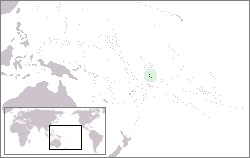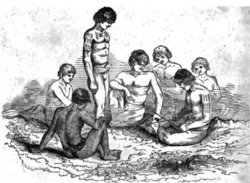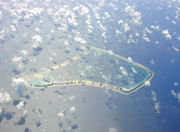Tokelau
2008/9 Schools Wikipedia Selection. Related subjects: Geography of Oceania (Australasia)
| Tokelau | ||||||
|---|---|---|---|---|---|---|
|
||||||
| Motto: Tokealau No Te Atua | ||||||
|
|
||||||
| Capital | None; each atoll has its own administrative centre. | |||||
| Official languages | Tokelauan, English | |||||
| Demonym | Tokelauan | |||||
| Government | Constitutional monarchy | |||||
| - | Head of State | Queen Elizabeth II | ||||
| - | Administrator | David Payton | ||||
| - | Head of Government | Pio Tuia | ||||
| New Zealand territory | ||||||
| - | Tokelau Act | 1948 | ||||
| Area | ||||||
| - | Total | 10 km² ( 228th) 5 sq mi |
||||
| - | Water (%) | negligible | ||||
| Population | ||||||
| - | 2007 estimate | 1,449 ( 220th) | ||||
| - | 2006 census | 1,4661 | ||||
| - | Density | 115/km² ( 86th) 298/sq mi |
||||
| GDP ( PPP) | 1993 estimate | |||||
| - | Total | $1.5 million ( 227th) | ||||
| - | Per capita | $1,035 ( not ranked) | ||||
| Currency | New Zealand dollar ( NZD) |
|||||
| Time zone | ( UTC-10) | |||||
| Internet TLD | .tk | |||||
| Calling code | +690 | |||||
| Some data from the World Factbook (2004). 1. Tuhiga Igoa o te 2006 - 2006 Tokelau Census of Population and Dwellings. The Census population figure of 1,466 includes 392 usual residents of Tokelau who were absent on census night. |
||||||
Tokelau (pronounced /ˈtoʊkəlaʊ/) is a territory of New Zealand that consists of three tropical coral atolls in the South Pacific Ocean. The United Nations General Assembly designated Tokelau a Non-Self-Governing Territory.
Until 1976 the official name was Tokelau Islands. Tokelau is sometimes referred to by Westerners by the older, colonial name of The Union Islands.
Etymology and consequences of name usage
The name Tokelau is a Polynesian word meaning "north wind". The islands were officially named the Union Islands and Union Group at unknown times. Tokelau Islands was adopted in 1946, which was contracted to Tokelau on 9 December 1976.
The change in usage between Tokelau Islands and Tokelau marks a slight shift in emphasis, with consequences in regional diplomacy, in that the term Tokelau Islands clearly and substantially refers to a geographical expression, that is, a range of islands, whatever else it may connote. Thus it is not necessarily controversial to refer to a range of islands by one name, even though politically they may come under two jurisdictions. Whereas Tokelau can be taken to refer more immediately to some concept of nationhood, arguably infusing increased meaning to the draft 2006 independence constitution of Tokelau which, controversially or not, defines Swains Island, currently part of American Samoa, as part of the national territory.
Geography
Tokelau comprises three atolls in the South Pacific Ocean between 171° and 173° W longitude and 8° and 10° S latitude, approximately midway between Hawaii and New Zealand. They lie about 500 km (311 mi) north of Samoa. The islands are Atafu, at one time known as the Duke of York Group, Nukunonu, also the Duke of Clarence Group, and Fakaofo, once Bowditch Island. Between them they comprise a land area of 10.8 km². There are no ports or harbours. Tokelau lies in the Pacific typhoon belt. A fourth island that is culturally, historically, and geographically, but not politically, part of the Tokelau chain is Swains Island (Olohega), under United States control since about 1900 and administered as part of American Samoa since 1925. The island was claimed by the United States pursuant to the Guano Islands Act as were the other three islands of Tokelau, which claims were ceded to Tokelau by treaty in 1979. In the draft constitution of Tokelau subject to the Tokelauan self-determination referendum in 2006, Olohega is claimed as part of Tokelau, a claim surrendered in the same 1979 treaty which established a boundary between American Samoa and Tokelau.
Tokelau's claim to Swains is generally comparable to the Marshall Islands' claim to US-administered Wake Island, but the re-emergence of this somewhat dormant issue has been an unintended result of the United Nations' recent efforts to promote decolonization in Tokelau. Basically, Tokelauans have proved somewhat reluctant to push their national identity in the political realm: recent decolonization moves have mainly been driven from outside for ideological reasons. But at the same time, Tokelauans are reluctant to disown their common cultural identity with Swains Islanders who speak their language.
Against the claim in Tokelau's draft constitution that Swains Island is part of Tokelau is the arguably telling symbolism of the three stars on the flag of Tokelau, representing Atafu, Nukunonu and Fakaofo, i.e., not including Swains Island (Olohega). The suggestion which could be inferred from this is that, in identifying with a three-star flag, supporters of Tokelau's independence do not actively expect Swains Island to be incorporated into any independent Tokelauan state that might emerge in the foreseeable future. In turn, against this it may be argued that, since the flag of Tokelau is neither currently official, nor the emblem of an internationally recognized sovereign state, then the number of stars, and the islands which they represent, cannot be regarded as conclusive indication as to the territorial aspirations of Tokelau's nationalists. By way of example in support of this is the fact that in the 1990s neighbouring Tuvalu, with which Tokelau has cultural affinities, varied the number of stars — representing islands — on different official versions of its national flag.
Tokelau is in a completely different time zone to most of New Zealand, being 10 hours behind Coordinated Universal Time (UTC) rather than 12 hours in front, meaning a 22 hour time difference for much of the year (New Zealand has daylight saving time (DST) for part of the year while Tokelau never participates). Tokelau is in the same time zone as the Cook Islands and Hawaii rather than neighbouring Samoa and American Samoa.
- Geographic locations of Tokelau's atolls
- Atafu:
- Nukunonu:
- Fakaofo:
History
Archaeological evidence indicates that the atolls of Tokelau — Atafu, Nukunonu, and Fakaofo — were settled about 1000 years ago, probably by voyages from Samoa, the Cook Islands and Tuvalu. Oral history traces local traditions and genealogies back several hundred years. Inhabitants followed Polynesian mythology with the local god Tui Tokelau; and developed forms of music (see Music of Tokelau) and art. The three atolls functioned largely independently while maintaining social and linguistic cohesion. Tokelauan society was governed by chiefly clans, and there were occasional inter-atoll skirmishes and wars as well as inter- marriage. Fakaofo, the "chiefly island," held some dominance over Atafu and Nukunonu. Life on the atolls was subsistence-based, with reliance on fish and coconut.
Western discovery and contact
Commodore John Byron discovered Atafu on 24 June 1765 and named it "Duke of York's Island." Parties onshore reported that there were no signs of current or previous inhabitants. Captain Edward Edwards, in knowledge of Byron's discovery, visited Atafu on 6 June 1791 in search of the Bounty mutineers. There were no permanent inhabitants, but houses contained canoes and fishing gear, suggesting the island was used as a temporary residence by fishing parties. On 12 June 1791, Edwards sailed southward and discovered Nukunonu, naming it "Duke of Clarence's Island". A landing party could not make contact with the people but saw "morais," burying places, and canoes with "stages in their middle" sailing across the lagoons.
On 29 October 1825 August R. Strong of the U.S.N Dolphin wrote of his crew's arrival at the atoll Nukunonu, "Upon examination, we found they had removed all the women and children from the settlement, which was quite small, and put them in canoes lying off a rock in the lagoon. They would frequently come near the shore, but when we approached they would pull off with great noise and precipitation." (The Journal of the South Pacific, 110 (3), pp.296).
On 14 February 1835 Captain Smith of the United States whaler General Jackson records discovering Fakaofo, calling it "D'Wolf's Island". On 25 January 1841, the United States Exploring Expedition visited Atafu and discovered a small population living on the island. The residents appeared to be temporary, evidenced by the lack of a chief and the possession of double canoes (used for inter-island travel). They desired to barter, and possessed blue beads and a plane-iron, indicating previous interaction with foreigners. The expedition reached Nukunonu on 28 January 1841 but did not record any information about inhabitants. On 29 January 1841, the expedition discovered Fakaofo and named it "Bowditch". The islanders were found to be similar in appearance and nature to those in Atafu.
Missionaries preached Christianity in Tokelau from 1845 to the 1860s. French Catholic missionaries on Uvea and missionaries of the Protestant London Missionary Society in Samoa used native teachers to convert the Tokelauans. Atafu was converted to Protestantism by the London Missionary Society, Nukunonu was converted to Catholicism and Fakofo was converted to both denominations. Peruvian slave traders arrived in 1863 and took nearly all (253) of the able-bodied men to work as labourers. The men died of dysentery and smallpox, and very few returned to Tokelau. With this loss, the system of governance became based on the "Taupulega", or "Councils of Elders", where individual families on each atoll were represented. During this time, Polynesian immigrants and American, Scottish, French, Portuguese and German beachcombers settled, marrying local women and repopulating the atolls.
Government
Villages are entitled to enact their own laws regulating their daily lives and New Zealand law only applies where it has been extended by specific enactment. Serious crime is rare and there are no prisons - offenders are publicly rebuked, fined or made to work
In 1877 the islands were included under the protection of Great Britain by an Order-in-council which claimed jurisdiction over all unclaimed Pacific Islands. Commander Oldham on HMS Egeria landed at each of the three atolls in June 1889 and officially raised the Union Flag, declaring the group a British protectorate. The British government annexed Tokelau to the colony of the Gilbert and Ellice Islands and transferred Tokelau to New Zealand administration in 1926, abolishing the islands' chiefdoms. By the Tokelau Act of 1948, sovereignty over Tokelau was transferred to New Zealand. Defence is also the responsibility of New Zealand. However, the Tokelauans are drafting a constitution and developing institutions and patterns of self-government as Tokelau moves towards free association with New Zealand, similarly to Niue and the Cook Islands.
Politics
The head of state is Elizabeth II, the Queen in right of New Zealand, who also reigns over the United Kingdom and the other Commonwealth Realms. The Queen is represented in the territory by Administrator David Payton. The current head of government is Kuresa Nasau, who presides over the Council for the Ongoing Governance of Tokelau, which functions as a cabinet. The Council consists of the Faipule (leader) and Pulenuku (village mayor) of each of the three atolls. The monarch is hereditary, the administrator appointed by the Minister of Foreign Affairs and Trade in New Zealand, and the office of head of government rotates between the three Faipule for a one-year term.
The Tokelau Amendment Act of 1996 confers legislative power on the General Fono, a unicameral body. The number of seats each atoll receives in the Fono is determined by population — at present, Fakaofo and Atafu both have eight and Nukunonu has seven. Faipule and Pukenuku (atoll leaders and village mayors) also sit in the Fono.
On 11 November 2004 Tokelau and New Zealand took steps to formulate a treaty that would turn Tokelau from a non-self-governing territory to a self-governing state in free association with New Zealand. Besides the treaty, a UN-sponsored referendum on self-determination took place, with the three islands voting on successive days starting 13 February 2006. (Tokelauans based in Apia, Samoa, voted on February 11.) . Out of 581 votes cast, 349 were for Free Association, being short of the two-thirds majority required for the measure to pass. The referendum was profiled (somewhat light-heartedly) in the 1 May 2006 issue of The New Yorker magazine. A repeat referendum took place on October 20-24, 2007, again narrowly failing to approve self-government. This time the vote was short by just 16 votes or 3%.
In May 2008, the United Nations' Secretary General Ban Ki-moon urged colonial powers "to complete the decolonization process in every one of the remaining 16 Non-Self-Governing Territories", including Tokelau. This led the New Zealand Herald to comment that the United Nations was "apparently frustrated by two failed attempts to get Tokelau to vote for independence".
Economy
According to the Central Intelligence Agency's list of countries by GDP (PPP) Tokelau has the smallest economy of any country in the world. Tokelau has an annual purchasing power of about US$1,000 (€674) per capita. The government is almost entirely dependent on subsidies from New Zealand. It has annual revenues of less than US$500,000 (€336,995) against expenditures of some US$2.8 million (€1.9 million). The deficit is made up by aid from New Zealand. Tokelau exports around US$100,000 (€67,400) of stamps, copra and handicrafts, woven and carved, annually and imports over US$300,000 (€202,197) of foodstuffs, building materials, and fuel to, and from, New Zealand. New Zealand also pays directly for the cost of medical and education services. Local industries include small-scale enterprises for copra production, wood work, plaited craft goods, stamps, coins, and fishing. Agriculture and livestock produces coconuts, copra, breadfruit, papayas, bananas, pigs, poultry and few goats. A large number of Tokelauans live in New Zealand and support their families in Tokelau through remittances.
Internet domain names
Tokelau has added 10% to its GDP through registrations of domain names under its top-level domain, .tk. Registrations can be either free, in which case advertising is displayed on the site along with other restrictions, or paid, which allows the domain owner to remove the advertising and other restrictions. Free domains are pointed to Tokelau name servers and the only services available are HTTP traffic being redirected via HTML frames to a specified address, where there is also a frame displaying advertising, and the redirection of up to five email address to external address (not at a .tk domain). Also, free domains have a minimum traffic limit of 25 unique visitors in any 90 day period. If this limit is not reached, the domain is suspended and the owner has either 10 days to convert the domain to a paid domain or have the domain deregistered.
In September 2003 Fakaofo became the first part of Tokelau with a high-speed Internet connection. Foundation Tokelau finances the project. Tokelau gives most domain names under its authority away to anyone for free to gain publicity for the territory. This has allowed the nation to gain enhanced telecommunications technologies, such as more computers and Internet access for Tokelauan residents.
Demographics
Tokelau (pronounced To'-keh-law) has a population of 1,433 (as of July 2008). This is 0.011% lower than 2007, showing a declining population. The nationals of Tokelau are called Tokelauans, and the major ethnic group are Polynesians, and the country has no minorities. The major religion is the Congregational Christian Church and the main language is Tokelauan, but English is also spoken.
Tokelau has fewer than 1,500 Polynesian inhabitants in three villages who speak Tokelauan and English. Their isolation and lack of resources greatly limits economic development and confines agriculture to the subsistence level. The very limited natural resources and overcrowding are contributing to emigration to New Zealand and Samoa, resulting in a population decline of about 0.9% per year. Depletion of tuna has made fishing for food more difficult.
On the island of Atafu almost all inhabitants are members of the Congregational Christian Church of Samoa. On Nukunonu almost all are Roman Catholic. On Fakaofo both denominations are present with the Congregational Christian Church predominant. The total proportions are: Congregational Christian Church 62%, Roman Catholic 34%, other 5%.
While slightly more females than males live on Atafu and Fakaofo, males make up 57% of Nukunonu residents. Only 9% of Tokelauans aged 40 or more have never been married. One quarter of the population were born overseas; almost all the rest live on the same atoll they were born on. Most households own 5 or more pigs.
Books and Publications
- Tokelau: a historical ethnography by Judith Huntsman & Antony Hooper (1996, Auckland University Press) ISBN 1869401530
- The Future of Tokelau: decolonising agendas by Judith Huntsman with Kelihiano Kalolo (2007, Auckland University Press) ISBN 9781869403980
- Tokelau by Peter McQuarrie (2008)





